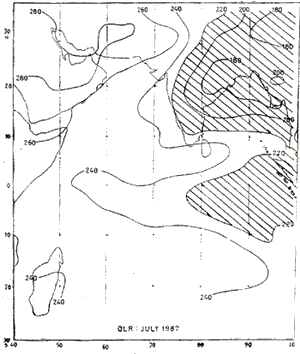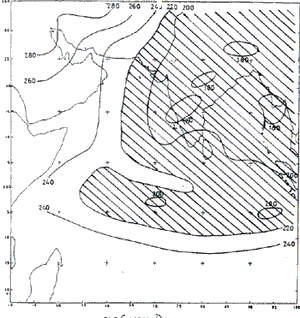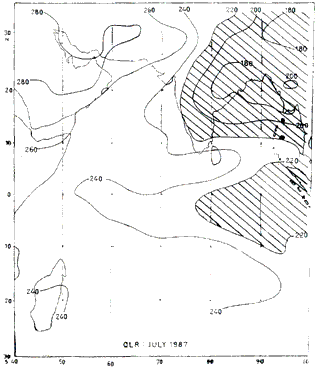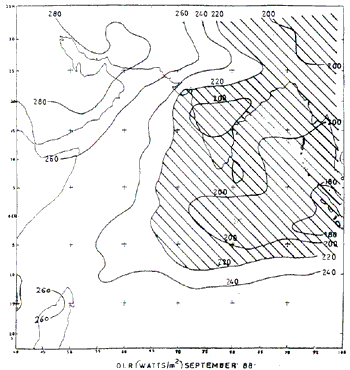| GISdevelopment.net ---> AARS ---> ACRS 1991 ---> Oceanography |
Connective activity over the
tropical Indian Ocean
M.R. Ramesh Kumar and L.V.
Gangadhara Rao
Physical Oceanography Division
National Institute of Oceanography
Dona Paula, Goa - 03004
Physical Oceanography Division
National Institute of Oceanography
Dona Paula, Goa - 03004
Abstract
The convective activity over the tropical Indian Ocean is studied in relation to monsoon activity over India for the years 1986, 1987 and 1988 using the outgoing long wave radiation (OLR) values from the satellite data (INSAT-1B) and the seas surface temperature data from satellite and institute observations (blend analysis).
The premonsoon OLR values were higher during a poor monsoon (1987) year as compared to the other two years. A high OLR value of 240 W/m2 was observed between 65° E and 85° E along the equatorial belt which was absent during 1986 and 1988. Further, it was observed that the OLR values were higher over the Indian subcontinent during the poor monsoon year (1987) as compared to the normal monsoon years (1986 and 1988). An analysis of the as surface temperature (SST) anomalies has shown that the positive SST anomalies have prevailed throughout the monsoon season in Arabian Sea in a poor monsoon year (1987), which may be probably due to weak cross equatorial flow off the Somali coast and weak winds over the Arabian Sea compared to the normal monsoon years (1986 and 1988). Thus higher OLR values over the Indian subcontinent and positive SST anomalies over the Arabian Sea appear to be responsible for poor monsoon rainfall lover Indian subcontinent in 1987.
Introduction
The summer monsoon rainfall (June to September) plays a vital role in the economy of an agricultural country like India, where about 70 to 90% of the annual rainfall is received during this period. In the present study we have used the outgoing longwave radiation (OLR) data for the three consecutive years 1987 and 1988 form the Indian National Satellite (INSAT) and the sea surface temperature (SST) anomalies data from the blend analysis of the Climate Analysis Centre, U.S.A for studying the role of the convective activity over the tropical Indian Ocean in relation to the summer monsoon activity/rainfall over the Indian subcontinent.
The OLR depicts the average upwelling flux of infrared radiation, which is largest where predominantly clear skies occurred and decreases in the cloudy areas/regions. The OLR is known to be a measure of convective activity over the tropical oceans where convection is one of the main source for precipitation. The OLR values have also been found to be useful input for Erath-Atmosphere radiation budget studies (Orhing and Gruber, 1983). Several, recent studies have shown that the OLR values are well correlated with the precipitation values (Lau and Cha, 1983; Arkin and Meisner, 1987; Arkin et al. 1989)
Data and Methodology
The SST data for the present study has been extracted from the mean fortnightly maps made from the blend SST charts for the years 1986, 1987 and 1988.
The monsoon rainfall data for the study has been extracted from the weekly weather reports of the Indian Meteorological Department (IMD) for the above years.
The OLR value used in the present study have been extracted from the IMD Monographs. The INSAT-1B has a very high resolution radiometer (VHRR) which has an infrared channel operation in the wavelength range of 10.5 um - 12.5 um
The daily OLR values were computed from the daily mean grids (of dimension 2.5° x 2.5° Lat/Long) temperatures. These were then further averaged for the monthly mean values. These OLR values are computed following :
Tf = Tr (a + b x Tr)
Where Tr is the brightness temperature (in K) as measured by the satellite and Tf is the flux temperature (in K) and a and b are constants (Ohring et al., 1984).
OLR = Tr4
Where is the Stefan Boltzmann's constant
A comparison between INSAT-1B derived OLr values with the NOAA OLR values have shown that they are very well correlated. Arkin et al. (1989)feels that eh INSAT-1B OLR values to be more superior to NOAA values because of more frequent sampling (that is upto 8 times a day rather than 2 to 4 times a day).
Results and Discussion
An analysis of the OLR values for the monsoon months (June to September) or 1986, 1987 and 1988 shows that the convective activity over the tropical Indian Ocean and the subcontinent was weak during the active phase of SW Monsoon (in the month of July) during poor monsoon year (1987) as compared to a good monsoon year (1988) (figure 1a and b). further, the monsoon withdraw, well in advance from the subcontinent during a poor monsoon year (1987) as compared to a good monsoon year (1988) (figures 2a and 2b).

Active Phase of SW monsoon

Active Phase of SW monsoon

Withdrawl Phase of SW monsoon

Withdrawl Phase of SW monsoon
An analysis of the SST anomalies for the above periods shows that the positive SST anomalies (figures not presented) were prevailing over throughout the monsoon season in the Arabian Sea in a poor monsoon year (1987) which can be due to weak surface winds. The cross equational flow off Somalia coast was also weak during a poor monsoon year (1987) as compared to normal monsoon years (1987 and 1988).
Thus, we feel that the cause for poor monsoon rainfall/activity in 1987 is primarily due to weak convection, weak surface winds over the Arabian sea and weak cross equational flow off Somalia coast as compared to normal monsoon years (1986 and 1988).
References
- Arkin P.A. and Meisner B.N, 1987: The relationship between large scale convective rainfall and cold cloud cover in the western Hemisphere during 1982-1984. Mon. Wea. Rev., 105, pp 51-74
- Arkin, P.A., A.V.R.K. Rao and R.R. Kelkar, 1989: Large Scale precipitation and outgoing longwave radiation from INSAT-1B data during 1986 southwest monsoon season, J. Climate, 2, pp 619-628.
- Lau K. and Chan P.H., 1983: short time climatic variability and atmospheric tele-connections from satellite observed outgoing longwave radiation. part I: simultaneous relationships. J.Atmos. Sci., 40, pp. 2735-2750.
- Ohring G. and Gruber A., 1983: Satellite Radiation Observation and climate theory : Adv. In Geophysics., 25, pp. 237-304.
- Ohring G., Gruber A and Ellignson R., 1984: Satellite Determination of the relationship between total longwave radiation flux and infrared window radiance. J. Clim. Appl. Meet., 23, pp 416-425.